What are Dental Implants?
Dental implants are small, screw-like posts made of biocompatible materials, usually titanium, that are surgically placed into the jawbone to replace missing teeth. They act as artificial tooth roots, providing a strong foundation for supporting various restorations like crowns, bridges, or even dentures.
Dental implants are most commonly made of titanium materials. Materials such as zirconia, stainless steel and gold are also sometimes used. The reason why titanium is chosen as a dental implant material is:
- Biocompatibility
- Strength and durability
- Corrosion resistance
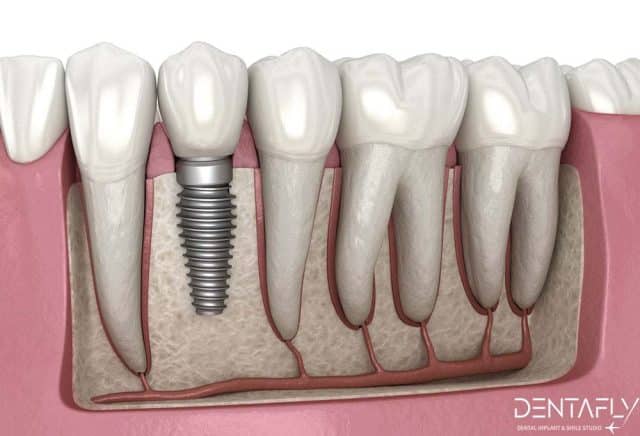
How do dental implants work?
Dental implants are materials that are titanium and mostly placed in the tooth root (instead of the missing tooth) by the oral and maxillofacial surgeon. The placed dental implant generally becomes fully compatible with the gums within 3 months. After this stage, a piece called “abutment” is placed on the dental implant. A crown is placed on the abutment dental implant by the dentist.
Dental implants are mostly accepted materials by NHS and other health communities. To make sure that a dental implant is known, it is necessary to verify it on the manufacturer’s website.
After examining the X-ray, the oral and maxillofacial surgeon places the dental implant in the most appropriate place to replace the real tooth, according to the bone and jaw structure. This surgery takes approximately 15 minutes.
The patient follows the procedures prescribed by the surgeon for a period of approximately 3 months to ensure that the dental implant placed in the jaw becomes fully compatible with the gums.
After the approximately 3-month healing process is completed, the surgeon checks the implant. If deemed appropriate, a zirconia or porcelain crown is placed on the implant by the dentist.

Mr. Dave came to Turkey for dental implant treatment. He tells about treatment process in this video review.
What to expect after dental implant surgery?
After undergoing dental implant surgery, it is essential to be aware of the recovery process and the experiences you might encounter as you heal. As your dentist, I aim to ensure you are well-informed and comfortable throughout this period.
In the immediate aftermath of the surgery, it is normal to experience some bleeding and redness in your saliva. This typically lasts for the first 24 to 48 hours. To manage this, you should gently bite on the gauze pads placed in your mouth at the end of the procedure. If bleeding persists or becomes excessive, please contact our office for further instructions.
Swelling is another common post-operative symptom, particularly around the mouth, cheeks, and eyes. This swelling usually peaks within the first two to three days and then begins to subside. To alleviate swelling, apply ice packs to the outside of your face intermittently—20 minutes on, 20 minutes off—during the initial 48 hours.
As the anesthesia wears off, you may experience some pain or discomfort. This is a typical part of the healing process. I will prescribe pain medication to help you manage this discomfort. Over-the-counter pain relievers, such as ibuprofen, can also be effective. Please follow the dosage instructions carefully and do not exceed the recommended amount.
Your diet should consist of soft foods for the first few days to avoid disturbing the implant site. Foods like yogurt, mashed potatoes, and smoothies are excellent choices. Additionally, refrain from consuming hot foods and drinks, as they can increase swelling and discomfort. It is advisable to chew on the side opposite the implant to protect the surgical site.
Maintaining oral hygiene is crucial, but you must be gentle around the area of the implant. I recommend rinsing your mouth with a saltwater solution or an antimicrobial mouthwash to keep the area clean. Avoid using a toothbrush near the implant site for the first few days to prevent irritation.
During the initial days following your surgery, it is important to limit physical activity. Avoid strenuous exercises and heavy lifting, as these can increase bleeding and swelling. Rest is essential to facilitate proper healing.
You will have scheduled follow-up appointments to monitor your healing progress. These appointments are vital to ensure that the implant is integrating well with the bone and that there are no complications. During these visits, I will assess the surgical site and provide you with any additional care instructions if necessary.
In summary, while some discomfort, swelling, and minor bleeding are expected after dental implant surgery, following these guidelines will aid in a smooth recovery. Should you have any concerns or experience any unusual symptoms, please do not hesitate to contact our office. We are here to support you every step of the way as you recover and look forward to the successful integration of your dental implant.
After undergoing dental implant surgery, some bleeding is to be expected. It’s important to distinguish between normal bleeding and excessive bleeding that might indicate a potential complication.
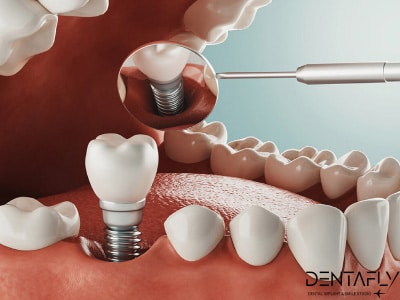
Dental Implant Reviews from Turkey
Maintaining meticulous oral hygiene after your dental implant surgery is crucial for optimal healing and long-term success. Also, patients should be careful right now: Brushing, flossing, health foods.

Facial bruising can occur during the dental implant process, although it’s not as common as swelling. Facial bruising after dental implant surgery is a possible, but not always common, side effect. While it’s generally not a cause for concern, it’s crucial to monitor the bruising and contact your dentist if you have any concerns about its severity or accompanying symptoms.

The specific medications recommended by a physician during or after dental implant treatment will vary depending on individual needs and potential risks.

After undergoing dental implant treatment, it’s crucial to be mindful of the foods you eat, especially during the initial healing period. Hard and crunchy foods can pose a threat to your new implants and hinder proper healing.

After getting dental implants, it’s crucial to adopt a specific eating pattern to promote proper healing and minimize risks. You can ensure a smooth healing process and enjoy your new implants for years to come. Remember, prioritizing a soft diet initially is crucial for successful implant integration and long-term success.

Are dental implants right for me?
You can ask your eligibility for dental implants to experienced doctors. Expert surgeons decide whether a patient is suitable for implant treatment. Fill out the form to review your eligibility.

Dental Implants vs. Dentures/Bridges
| Feature | Dental Implants | Dentures/Bridges |
|---|---|---|
| Placement | Surgically inserted into the jawbone | Rested on gums or anchored to surrounding teeth |
| Stability | Highly stable and integrated with the jawbone | Can become loose or shift over time |
| Comfort | Feel and function like natural teeth | May cause discomfort or irritation of gums |
| Appearance | Most natural-looking option | Can appear bulky or unnatural |
| Speech | No impact on speech | May affect speech initially |
| Eating | No restrictions on normal diet | May limit certain foods to prevent slippage or damage |
| Oral health | Preserve bone health and stimulate surrounding tissues | Can lead to bone loss over time |
| Durability | Last for decades with proper care | Need to be replaced every 5-10 years |
| Cost | More expensive than dentures/bridges | More affordable initially |
| Procedure | Requires surgery and healing time | Non-surgical, immediate results |
| Maintenance | Regular brushing and flossing | Regular cleaning and potential adjustments |
| Suitability | Good for most patients with healthy jawbone | Not suitable for everyone, especially those with weak jawbone or medical conditions |
Cost Comparison: Dental Implants vs. Dental Implant Alternatives
| Option | Single Unit | Full Treatment | Average Range | Notes |
|---|---|---|---|---|
| Dental Implants Cost | £1,500-£3,000 (incl. crown) | £25,000-£50,000 | £1,500-£3,000 per implant | More upfront cost, but long-term investment due to durability. |
| Dentures Cost | £600-£1,500 (per plate) | £1,500-£3,000 (upper/lower) | £1,500-£5,000 (full/immediate) | Affordable initially, but potential future replacements and adjustments. |
| Bridges Cost | £2,000-£5,000 (per pontic) | £4,000-£15,000 | £2,000-£5,000 (traditional) | Varies based on type (traditional, implant-supported). |
Dental Implant Reviews from Turkey | Dentafly Clinic 2024
Dental Implant Procedures: Turkey Vs. UK
| Aspect | Turkey | UK |
|---|---|---|
| Cost | Significantly lower costs (80-90% cheaper than the UK). | Higher costs, rarely covered by NHS unless medically necessary. |
| Quality of Care and Expertise | High standards with advanced technology, though varies by clinic. Dentists often trained internationally. | Highly regulated with mandatory registration. Consistently high standards of care. |
| Travel and Convenience | Popular for combining treatment with tourism; travel and accommodation add to costs. | Convenient for residents; international patients face high costs and travel. |
| Language and Communication | Many dentists speak English, but potential language barriers exist. | No language barriers for English speakers. |
| Aftercare and Follow-ups | Complicated by distance if issues arise after returning home. Dentafly provides aftercare guarantee. | Easier management of follow-ups and continuity of care locally. |
Dental implant procedures in Turkey and the UK offer different experiences and benefits, largely influenced by factors like cost, expertise, and healthcare standards. Here’s a comparative overview:
The cost of dental implants in Turkey, as presented on Dentafly’s website, varies significantly depending on the brand and type of implant chosen. The general range for standard dental implants is from £550 to £890 for brands like Hiossen and Straumann BLX. More specialized options like the Straumann Zygoma implants can be much higher, costing around £17,000 (DentaFly Implant Costs) (Dental Implant Packages).
All-on-four treatments, which are a popular choice for comprehensive dental restoration, start from around £3,000 and can go up to £5,450 depending on the specific brand and additional treatments like sinus lifting. This pricing is significantly lower compared to costs in the UK, where similar treatments can range from £13,000 to £16,000. This substantial price difference highlights Turkey as a cost-effective destination for dental tourism (DentaFly All on 4 Costs).
The affordability of implants in Turkey does not compromise the quality. Clinics like Dentafly emphasize the use of high-quality materials and advanced technologies such as immediate restoration implants that can be completed in a single visit, enhancing both the convenience and effectiveness of the treatment.
For more detailed and specific pricing, you can visit Dentafly’s official pricing page: Dental Implant Costs at Dentafly. Here, you’ll find up-to-date cost information for various implant options and treatments offered in 2024.
Dental Implant Before and After Gallery


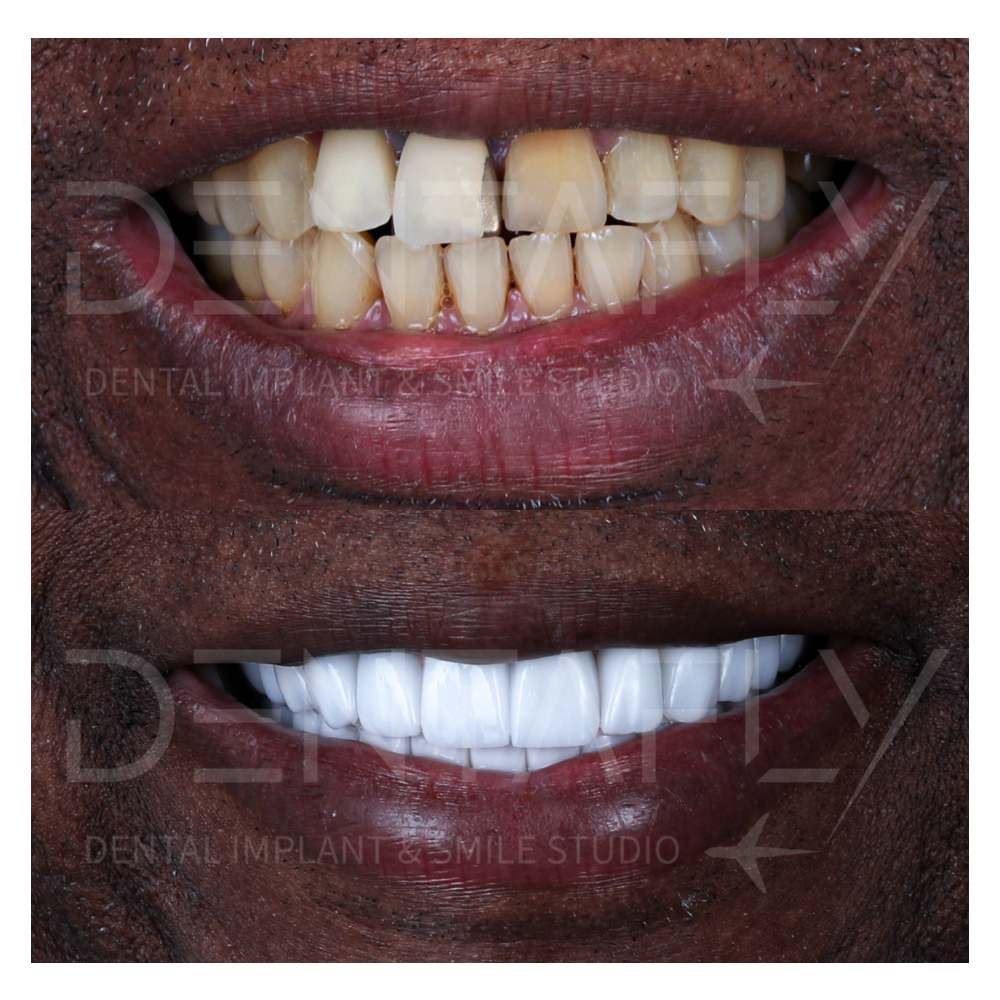
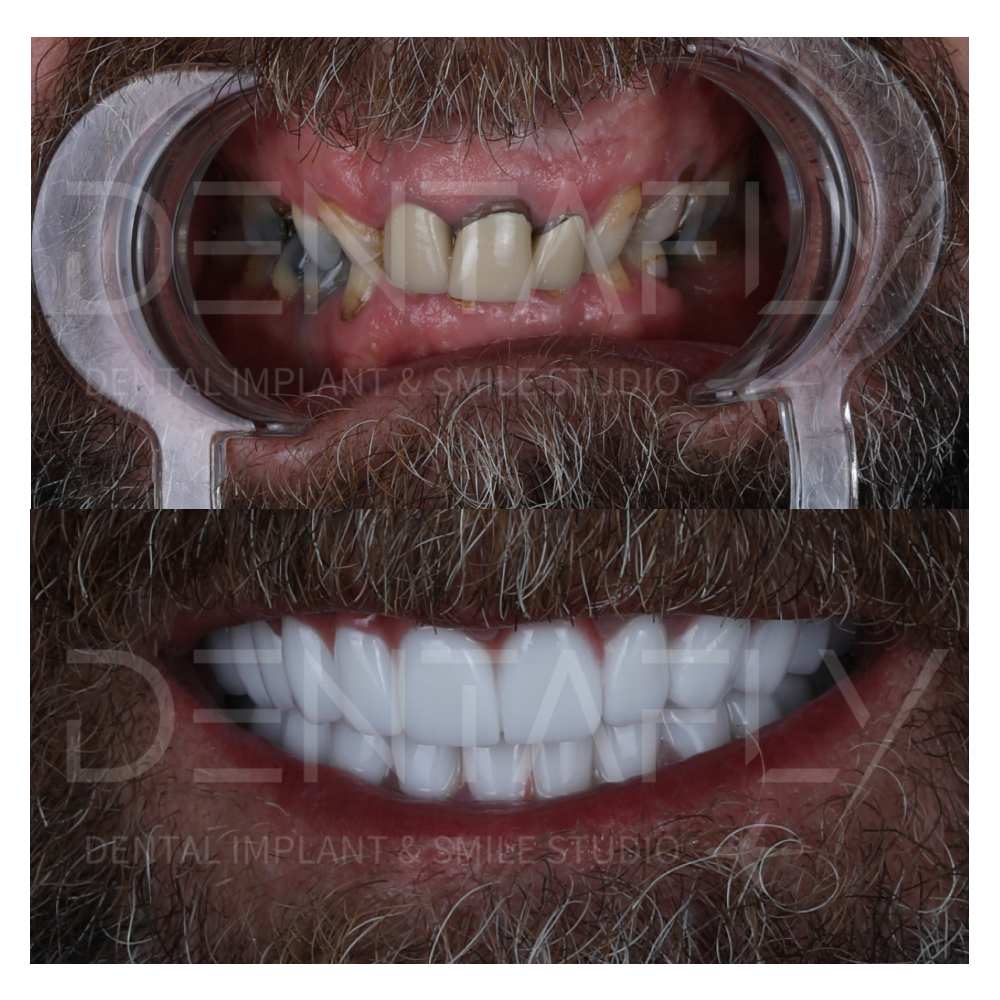
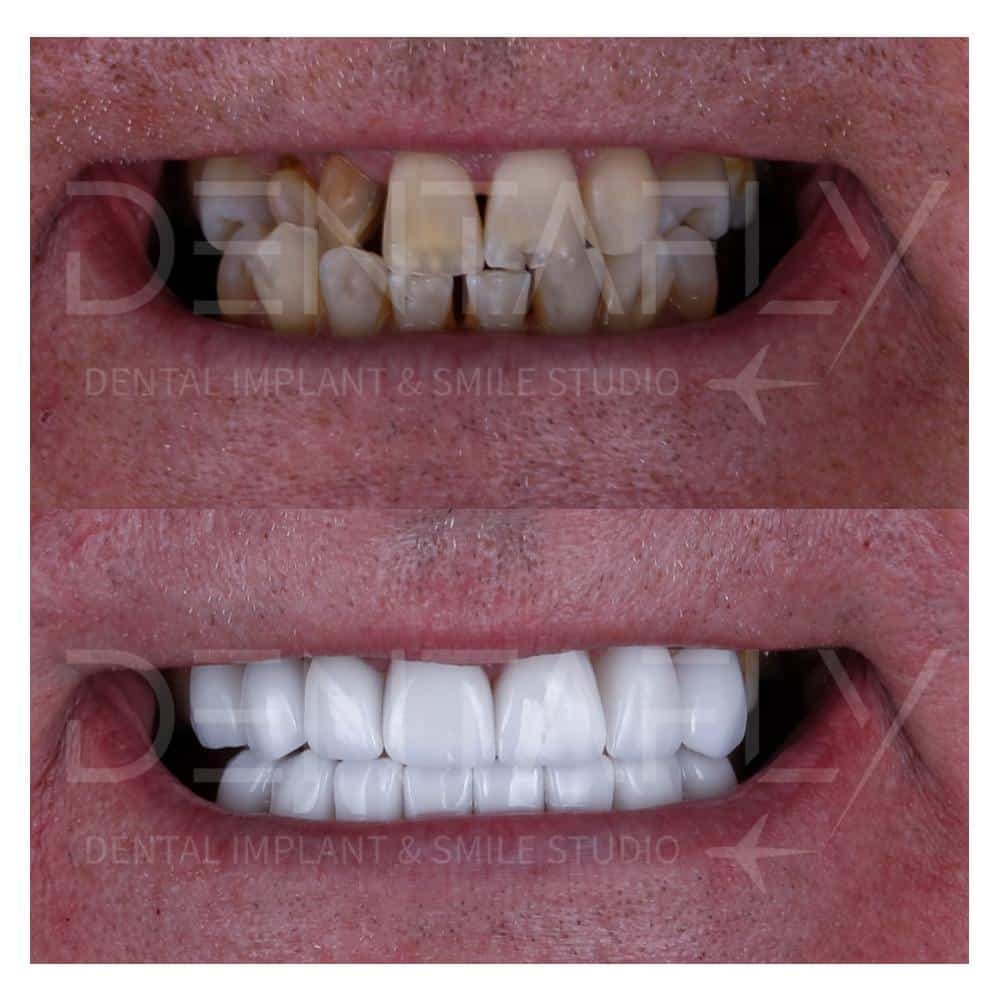
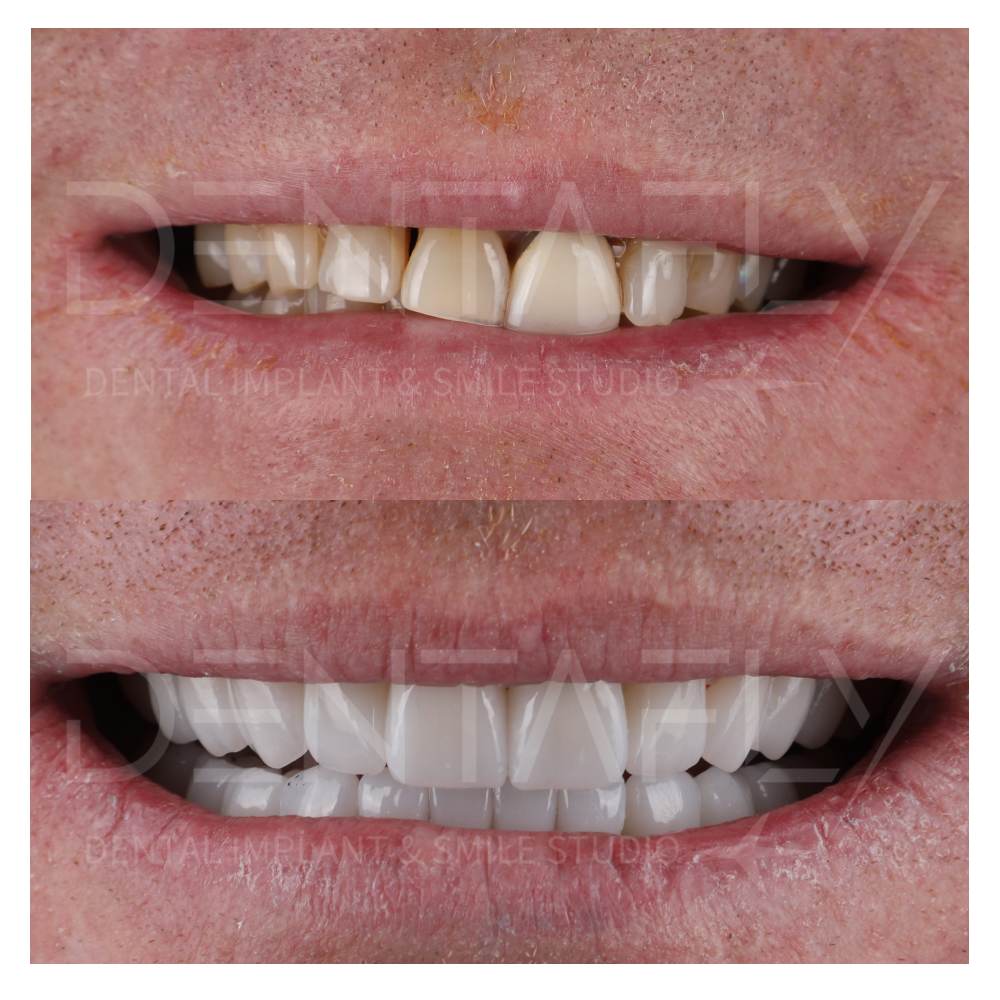
Alternatives to Dental Implants: Comprehensive Solutions for Missing Teeth
As dental professionals, we understand that missing teeth can significantly impact a patient’s quality of life, affecting their ability to chew, speak, and smile confidently. While dental implants are a popular and effective solution, they may not be suitable for everyone due to various factors such as cost, medical conditions, or personal preferences. Fortunately, there are several alternative treatments available that can effectively restore the function and aesthetics of missing teeth. This article explores these alternatives in detail, offering insights into their benefits, limitations, and suitability for different patient needs.
1. Dental Bridges
Dental bridges are a common alternative to implants, used to replace one or more missing teeth. They consist of artificial teeth (pontics) anchored to the adjacent natural teeth (abutment teeth). There are several types of dental bridges:
- Traditional Bridges: These involve creating crowns for the teeth on either side of the gap and placing a pontic in between. This type is suitable for patients with healthy adjacent teeth that can support the crowns.
- Cantilever Bridges: Used when there are teeth on only one side of the gap. This option is less common and typically used for areas that are under less stress, such as the front teeth.
- Maryland Bonded Bridges: These use a framework of metal or porcelain bonded to the back of adjacent teeth. They are less invasive but may not be as strong as traditional bridges.
Benefits:
- Less invasive than implants
- Faster procedure with fewer appointments
- Generally more affordable than implants
Limitations:
- Requires alteration of adjacent healthy teeth
- May not be as durable as implants
- Risk of decay in supporting teeth
2. Dentures
Dentures are removable appliances that replace missing teeth and surrounding tissues. They come in two main types:
- Complete Dentures: Used when all teeth are missing in either the upper or lower jaw. These can be further classified into conventional (made after the gums have healed post-extraction) and immediate (made in advance and placed immediately after teeth are removed).
- Partial Dentures: Suitable for patients who still have some natural teeth remaining. They consist of replacement teeth attached to a gum-colored plastic base, which may be connected by metal framework.
Benefits:
- Non-invasive and reversible
- Can be adjusted or replaced easily
- Affordable and relatively quick to produce
Limitations:
- Can be uncomfortable and may require adjustment periods
- May slip or move while eating or speaking
- Require regular maintenance and cleaning
3. Resin-Bonded Bridges
Resin-bonded bridges (also known as Maryland bridges) are another less invasive alternative, particularly useful for missing front teeth. These bridges involve a metal or porcelain framework bonded to the back of the adjacent natural teeth, supporting the artificial tooth in between.
Benefits:
- Minimal alteration of adjacent teeth
- Less invasive than traditional bridges or implants
- Aesthetic results for visible front teeth
Limitations:
- Less durable than other options
- Not suitable for areas with high bite pressure
- Potential for debonding over time
4. Flipper
A flipper is a temporary partial denture that can be used to fill gaps from missing teeth. It is typically made from acrylic and is designed to be a temporary solution while patients wait for a more permanent treatment, such as a bridge or implant.
Benefits:
- Quick and cost-effective temporary solution
- Non-invasive
- Provides aesthetic improvement
Limitations:
- Not a permanent solution
- Less stable and comfortable than other options
- Can break or wear out quickly
5. Bonding
Dental bonding involves applying a tooth-colored resin to the teeth to correct minor imperfections or close small gaps. While not a direct replacement for missing teeth, bonding can be used to improve the appearance of a smile if a patient has small gaps or is missing a small part of a tooth.
Benefits:
- Minimally invasive
- Quick procedure with immediate results
- Cost-effective
Limitations:
- Not suitable for large gaps or multiple missing teeth
- Less durable than other options
- Requires regular maintenance
6. Orthodontic Solutions
Orthodontic solutions, such as braces or clear aligners (e.g., Invisalign), can sometimes be used to close gaps caused by missing teeth by gradually shifting the remaining teeth into the correct position. This method is typically used for minor gaps and is often combined with other treatments for comprehensive results.
Benefits:
- Non-invasive
- Improves overall dental alignment
- Long-term results
Limitations:
- Time-consuming (often requires several months to years)
- Not suitable for all types of gaps
- Requires commitment to wearing braces or aligners
7. Overdentures
Overdentures are similar to traditional dentures but are designed to fit over the remaining natural teeth or dental implants. They provide a more stable and secure fit than traditional dentures.
Benefits:
- Improved stability compared to traditional dentures
- Helps preserve remaining natural teeth
- Can be removed for cleaning
Limitations:
- Requires sufficient remaining teeth or implants for support
- More expensive than traditional dentures
- May still require periodic adjustments
Choosing the right alternative to dental implants depends on various factors, including the patient’s oral health, budget, and personal preferences. Dental bridges, dentures, resin-bonded bridges, flippers, bonding, orthodontic solutions, and overdentures each offer unique benefits and limitations. Consulting with a dental professional is essential to determine the most suitable option for restoring your smile and maintaining oral health.
For those who cannot or prefer not to undergo dental implant surgery, these alternatives provide viable solutions that can effectively restore function and aesthetics. Each option should be carefully considered with the guidance of a qualified dentist to ensure the best possible outcome for your dental health and overall well-being.



